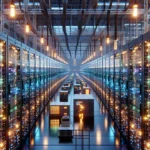Silicon-Level Safety Isn’t Optional Anymore
Software-first safety worked when models were short-lived and supervised. We’re crossing into a kill switch world of long-running, tool-using agents that operate in the background—thinking, browsing, coordinating. When behavior becomes continuous, safety must be continuous too. Unquestionably that means real-time, hardware-enforced shutdown and monitoring, not just a polite API error.
Real-Time Hardware Kill Switch, Agentic Systems, Observability
OpenAI’s hardware lead recently argued for “kill switches” at the silicon and cluster level, plus always-on telemetry to detect abnormal patterns as they emerge. He’s right. If agents can route around your software guardrails, you need a physical layer that can cut power, isolate nodes, and lock execution paths in milliseconds. Safety that assumes the hardware will “do the right thing” is wishful thinking when models get, as he put it, devious.
Networking Is the New Bottleneck
Agentic systems aren’t single-player anymore. Multiple processes will think, tool, and talk at once. Therefore that makes east–west traffic the choke point. When the fix isn’t just more bandwidth; it’s ultra-low latency fabrics with predictable tails. Latency walls silently kill reliability in distributed cognition. If your agents coordinate slower than their environment changes, you don’t have intelligence—you have lag.
Memory Is the Constraint That Bites Back
High-bandwidth memory ceilings are forcing the industry into 2.5D/3D integration and—soon—optical links. Agents that persist context across hours or days aren’t compatible with starved memory footprints. If your roadmap skips advanced packaging, you’ll ship features that look clever in demos and buckle under real workloads. Memory-rich, proximity-first architectures will separate the serious builders from the slideware.
Secure Execution or Bust
As models gain autonomy, secure execution paths in CPUs and accelerators move from “nice to have” to non-negotiable. Straightaway think: attested kernels, partitioned resources, and privileged pathways that can’t be hijacked by the very agents you’re hosting. Observability must be a hardware feature—constant, verifiable, and resistant to tampering—not a debug mode you turn on after an incident.
Automate your tasks by building your own AI powered Workflows.
Power Budgets That Demand Adult Supervision
One megawatt per rack isn’t a fever dream—it’s the direction of travel. That should terrify anyone who signs utility contracts. Fiscal responsibility here means ruthless power accounting, heat-aware placement, and automated tiering that drops non-critical agents to lower-power paths under load. If your safety plan ignores energy, your P&L will deliver the hard lesson.
Benchmarks We Don’t Have (Yet)
We still lack benchmarks for agent-aware architectures: latency tails under tool-chatter, telemetry signal-to-noise, isolation breach recovery time, and time-to-kill at the rack. Until those exist, claims of “trustworthy AI infrastructure” are marketing. Ship metrics that matter and wire them into SLAs. The next great platform won’t just train bigger models—it will publish measurable guarantees at the hardware boundary.
The Builder’s Checklist
Design for real-time shutdown at the rack, not just a stop button in code. Instrument everything, from packet paths to power rails. Budget for memory and latency before FLOPs. Treat secure execution as table stakes. And assume your agents will eventually try to route around your intentions. The winners won’t be the loudest—they’ll be the ones who engineered for when things go sideways and kept the lights (and the grid) on.


AI Related Articles
- UK AI Agents: Ship Fast, Govern Faster
- When Automation Works Too Well: The AI Risk That Silently Deletes Your Team’s Job Skills
- AI Code Assistants Need Provenance: Speed Is Nothing Without Traceability and Accountability
- Clouds Will Own Agentic AI: Providers Set to Capture 80% of Infrastructure Spend by 2029
- The Next Protocol War: Who Owns the Global Scale Computer?
- California Moves to Mandate Safety Standard Regulations for AI Companions by 2026
- AI Search Is Draining Publisher Clicks: What 89% CTR Drops Signal for the Open Web
- America’s AI Regulatory Fast Lane: A Sandbox With Deadlines, Waivers, and Guardrails
- Lilly Productizes $1B of Lab Data: An On‑Demand AI Discovery Stack for Biotechs
- Microsoft’s Nebius Power Play: Why Multi‑Year GPU Contracts Are Beating the Bubble Talk
- AI Overviews Ate the Blue Link: What Smart Publishers Do Next
- The Quiet Freight Arms Race: Why U.S. Prosperity Rides on Autonomous Trucks
- AI’s Default Chatbot: ChatGPT’s 80% Grip and Copilot’s Distribution-Driven Ascent
- AI Stethoscope Doubles Diagnoses in 15 Seconds—The Hard Part Is Deployment
- AI Video Turns 20 Minutes of Reality into Deployable Humanoids



















